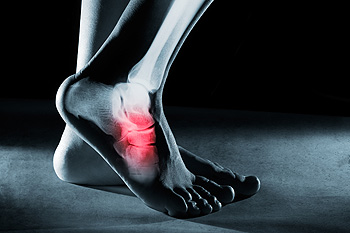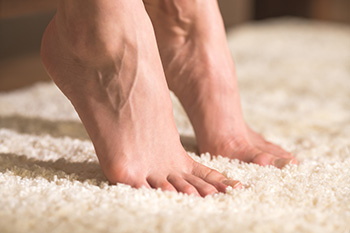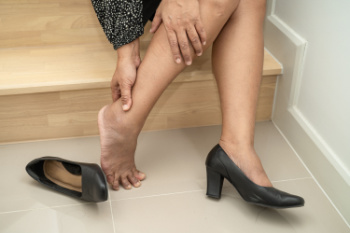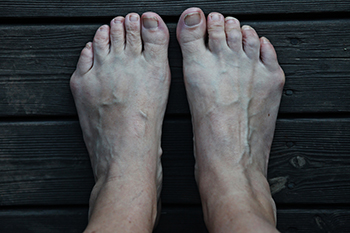Items filtered by date: October 2024
Protecting Your Feet From Workplace Falls

Workplace falls are a significant safety concern that can lead to serious injuries, particularly to the feet. Preventing these incidents requires awareness of both unsafe actions and unsafe conditions. Common unsafe actions include rushing, not using handrails on stairs, and failing to keep walkways clear of obstacles. Unsafe conditions often involve wet floors, poor lighting, and uneven surfaces, which can increase the risk of slips and trips. To minimize the likelihood of falls, it is essential that a clean and organized work environment is maintained, proper lighting is ensured, and spills are addressed promptly. Additionally, appropriate footwear with good traction can help protect the feet from injury. Falling can seriously impact the feet and may cause a temporary loss of wages. If you have injured your feet from falling at work, it is suggested that you consult a podiatrist who can offer you effective treatment solutions and appropriate fall prevention advice.
Preventing falls among the elderly is very important. If you are older and have fallen or fear that you are prone to falling, consult with Darline Kulhan, DPM from Scarsdale Foot Specialists PC. Our doctor will assess your condition and provide you with quality advice and care.
Every 11 seconds, an elderly American is being treated in an emergency room for a fall related injury. Falls are the leading cause of head and hip injuries for those 65 and older. Due to decreases in strength, balance, senses, and lack of awareness, elderly persons are very susceptible to falling. Thankfully, there are a number of things older persons can do to prevent falls.
How to Prevent Falls
Some effective methods that older persons can do to prevent falls include:
- Enrolling in strength and balance exercise program to increase balance and strength
- Periodically having your sight and hearing checked
- Discuss any medications you have with a doctor to see if it increases the risk of falling
- Clearing the house of falling hazards and installing devices like grab bars and railings
- Utilizing a walker or cane
- Wearing shoes that provide good support and cushioning
- Talking to family members about falling and increasing awareness
Falling can be a traumatic and embarrassing experience for elderly persons; this can make them less willing to leave the house, and less willing to talk to someone about their fears of falling. Doing such things, however, will increase the likelihood of tripping or losing one’s balance. Knowing the causes of falling and how to prevent them is the best way to mitigate the risk of serious injury.
If you have any questions, please feel free to contact our office located in Scarsdale, NY . We offer the newest diagnostic and treatment technologies for all your foot care needs.
How Foot Stress Fractures are Diagnosed

A foot stress fracture is a small, hairline crack in a bone resulting from repetitive stress or overuse, commonly occurring in athletes and active individuals. Symptoms typically include localized pain that intensifies with activity, tenderness when pressure is applied, and swelling around the affected area. Causes often involve increased physical activity, improper footwear, or sudden changes in exercise routines. Conditions like osteoporosis can also contribute to the risk of stress fractures. Diagnosing a foot stress fracture usually begins with a thorough physical examination by a podiatrist who will assess pain levels and check for tenderness. Imaging tests, such as X-rays or MRI scans, may be necessary to confirm the diagnosis and rule out other injuries. Early detection is vital for effective treatment and recovery, allowing individuals to return to their activities safely. If you have sustained a foot stress fracture, contact a podiatrist for treatment.
Stress fractures occur when there is a tiny crack within a bone. To learn more, contact Darline Kulhan, DPM from Scarsdale Foot Specialists PC. Our doctor can provide the care you need to keep you pain free and on your feet.
How Are They Caused?
Stress fractures are the result of repetitive force being placed on the bone. Since the lower leg and feet often carry most of the body’s weight, stress fractures are likely to occur in these areas. If you rush into a new exercise, you are more likely to develop a stress fracture since you are starting too much, too soon. Pain resulting from stress fractures may go unnoticed at first, however it may start to worsen over time.
Risk Factors
- Gender – They are more commonly found in women compared to men.
- Foot Problems – People with unusual arches in their feet are more likely to develop stress fractures.
- Certain Sports – Dancers, gymnasts, tennis players, runners, and basketball players are more likely to develop stress fractures.
- Lack of Nutrients – A lack of vitamin D and calcium may weaken the bones and make you more prone to stress fractures
- Weak Bones – Osteoporosis can weaken the bones therefore resulting in stress fractures
Stress fractures do not always heal properly, so it is important that you seek help from a podiatrist if you suspect you may have one. Ignoring your stress fracture may cause it to worsen, and you may develop chronic pain as well as additional fractures.
If you have any questions, please feel free to contact our office located in Scarsdale, NY . We offer the newest diagnostic and treatment technologies for all your foot care needs.
Keep Your Feet Healthy So You Can Stay Active
Exercises to Build Ankle Strength

Ankle strengthening exercises can improve stability and reduce the risk of injuries like sprains or strains. The ankle joint supports body weight and enables movement, so keeping its muscles, tendons, and ligaments strong is vital. Exercises such as calf raises, towel curls, and the ankle rotations target these areas and help prevent weakness that may lead to injury. Regular strengthening can also enhance your balance and flexibility, which is especially useful for athletes or others recovering from a sprain or strain. Tight or weakened ankles can limit mobility and inhibit carrying out daily activities, but consistent exercise can help alleviate these issues. A podiatrist can guide you in selecting the right exercises and provide personalized advice based on your particular condition. Incorporating these exercises into a regular routine can promote overall foot and ankle health. If you have ankle instability, it is suggested that you schedule an appointment with a podiatrist who can guide you on what type of ankle strengthening excercises to perform.
Exercising your feet regularly with the proper foot wear is a great way to prevent injuries and build strength. If you have any concerns about your feet, contact Darline Kulhan, DPM from Scarsdale Foot Specialists PC. Our doctor can provide the care you need to keep you pain-free and on your feet.
Exercise for Your Feet
Exercise for your feet can help you gain strength, mobility and flexibility in your feet. They say that strengthening your feet can be just as rewarding as strengthening another part of the body. Your feet are very important, and we often forget about them in our daily tasks. But it is because of our feet that are we able to get going and do what we need to. For those of us fortunate enough to not have any foot problems, it is an important gesture to take care of them to ensure good health in the long run.
Some foot health exercises can include ankle pumps, tip-toeing, toe rises, lifting off the floor doing reps and sets, and flexing the toes. It is best to speak with Our doctor to determine an appropriate regimen for your needs. Everyone’s needs and bodies are different, and the activities required to maintain strength in the feet vary from individual to individual.
Once you get into a routine of doing regular exercise, you may notice a difference in your feet and how strong they may become.
If you have any questions please feel free to contact our office located in Scarsdale, NY . We offer the newest diagnostic and treatment technologies for all your foot and ankle needs.
Comparing Rheumatoid Arthritis and Gout Foot Pain

Rheumatoid arthritis, or RA, and gout are two distinct forms of arthritis that can cause significant foot pain. RA is an autoimmune condition that leads to swelling, stiffness, and inflammation in the joints, including those in the feet. This inflammation can result in joint damage if left untreated. Gout occurs when uric acid crystals accumulate in the joints, often causing sudden and intense pain, redness, and swelling. It typically causes painful flare ups in the big toe. While RA tends to cause more generalized joint discomfort, gout pain is more localized and can be severe during flare-ups. Both arthritic conditions can limit mobility and interfere with your daily activities. A podiatrist can evaluate your symptoms and suggest treatment that helps manage pain, reduce inflammation, and prevent further joint damage. Included are certain medications, targeted exercises and lifestyle or diet adjustments. If you have inflammatory pain in your feet, it is suggested that you schedule an appointment with a podiatrist for a diagnosis and the appropriate treatment.
When dealing with systemic disease of the feet, it is extremely important to check the affected areas routinely so that any additional problems are caught quickly. If you have any concerns about your feet and ankles contact Darline Kulhan, DPM from Scarsdale Foot Specialists PC. Our doctor will assist you with all of your podiatric needs.
Systemic Diseases of the Feet
Systemic diseases affect the whole body, and symptoms usually are displayed in the feet. This condition can make a patient’s ability to walk unbearable. Systemic diseases include gout, diabetes mellitus, neurological disorders, and arthritis.
Gout – is caused by an excess of uric acid in the body. Common symptoms include pain, inflammation, and redness at the metatarsal/phalangeal joint of the base big toe. Gout can be treated by NSAIDs to relieve pain and inflammation, and other drugs that lower the acid levels in the body.
Diabetes mellitus – is an increase in the level of blood sugar that the body cannot counteract with its own insulin. Failure to produce enough insulin is a factor in Diabetes.
Diabetes of the Feet
Diabetic Neuropathy – may lead to damaged nerves and affect the feet through numbness and loss of sensation.
Peripheral Vascular Disease – can restrict the blood flow to the feet, and often times lead to amputation of the feet.
If you have any questions please feel free to contact our office located in Scarsdale, NY . We offer the newest diagnostic and treatment technologies for all your foot and ankle needs.
What Is Tailor’s Bunion?

Tailor’s bunion, or bunionette, is a bony bump that forms on the outside of the foot near the base of the little toe. Unlike a traditional bunion, which affects the big toe, a tailor’s bunion results from the little toe pushing towards the fourth toe, causing the joint to protrude. This condition is often caused by wearing tight or narrow shoes that compress the toes, as well as genetic factors that contribute to abnormal foot mechanics. Symptoms include pain, swelling, and redness surrounding the bunionette, which can make wearing shoes uncomfortable. The bump can also cause calluses to develop on the affected area due to increased friction. For persistent issues or severe discomfort from a bunionette, it is suggested you schedule an appointment with a podiatrist to explore treatment options.
If you are suffering from bunions, contact Darline Kulhan, DPM of Scarsdale Foot Specialists PC. Our doctor can provide the care you need to keep you pain-free and on your feet.
What Is a Bunion?
A bunion is formed of swollen tissue or an enlargement of boney growth, usually located at the base joint of the toe that connects to the foot. The swelling occurs due to the bones in the big toe shifting inward, which impacts the other toes of the foot. This causes the area around the base of the big toe to become inflamed and painful.
Why Do Bunions Form?
Genetics – Susceptibility to bunions are often hereditary
Stress on the feet – Poorly fitted and uncomfortable footwear that places stress on feet, such as heels, can worsen existing bunions
How Are Bunions Diagnosed?
Doctors often perform two tests – blood tests and x-rays – when trying to diagnose bunions, especially in the early stages of development. Blood tests help determine if the foot pain is being caused by something else, such as arthritis, while x-rays provide a clear picture of your bone structure to your doctor.
How Are Bunions Treated?
- Refrain from wearing heels or similar shoes that cause discomfort
- Select wider shoes that can provide more comfort and reduce pain
- Anti-inflammatory and pain management drugs
- Orthotics or foot inserts
- Surgery
If you have any questions, please feel free to contact our office located in Scarsdale, NY . We offer the newest diagnostic and treatment technologies for all your foot care needs.

